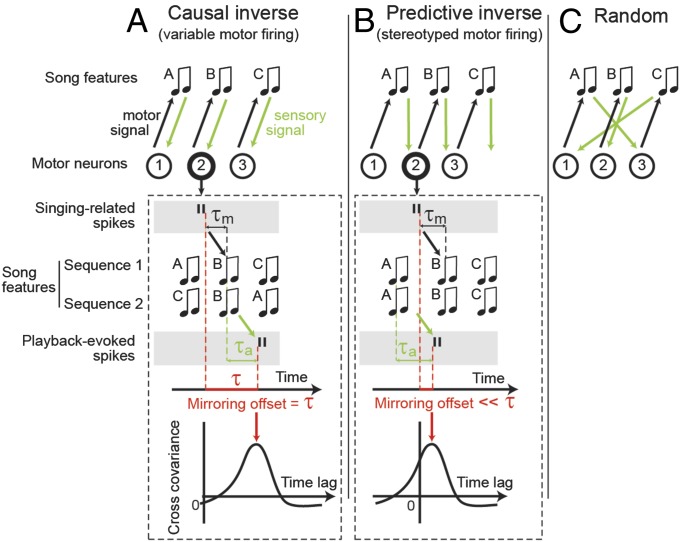Fig. 1.
Three hypothetical sensorimotor mappings and associated mirroring offsets. Sensory-to-motor mappings could implement a causal inverse of the motor plan (A), a predictive inverse (B), or be random (C). Under a causal inverse, generated by variable sequences of song features (ABC-CBA), a spike burst in a motor neuron (neuron 2) triggers the production (black arrow) of a song feature (feature B) after latency  , and the neuron receives sensory feedback (thick green arrow) from that same feature after an additional latency
, and the neuron receives sensory feedback (thick green arrow) from that same feature after an additional latency  . In such a neuron, we expect to see a cross-covariance (CC) peak (red arrow) between singing-related and playback-evoked spike bursts (black vertical bars) at a time lag (the so-called mirroring offset, red horizontal bar) given by the delay of the sensorimotor loop
. In such a neuron, we expect to see a cross-covariance (CC) peak (red arrow) between singing-related and playback-evoked spike bursts (black vertical bars) at a time lag (the so-called mirroring offset, red horizontal bar) given by the delay of the sensorimotor loop  . Under a predictive inverse (B), generated by stereotyped sequences of song features (ABC-ABC), the motor neuron 2 again triggers song feature B, but at the same time receives reliable feedback from the previous song feature A (thick green arrow). Thus, we expect to see a CC peak at a time lag much smaller than the sensorimotor loop delay
. Under a predictive inverse (B), generated by stereotyped sequences of song features (ABC-ABC), the motor neuron 2 again triggers song feature B, but at the same time receives reliable feedback from the previous song feature A (thick green arrow). Thus, we expect to see a CC peak at a time lag much smaller than the sensorimotor loop delay  . Finally, under a random sensory-to-motor mapping (C), we expected no CC between the motor- and sensory-evoked firing.
. Finally, under a random sensory-to-motor mapping (C), we expected no CC between the motor- and sensory-evoked firing.

